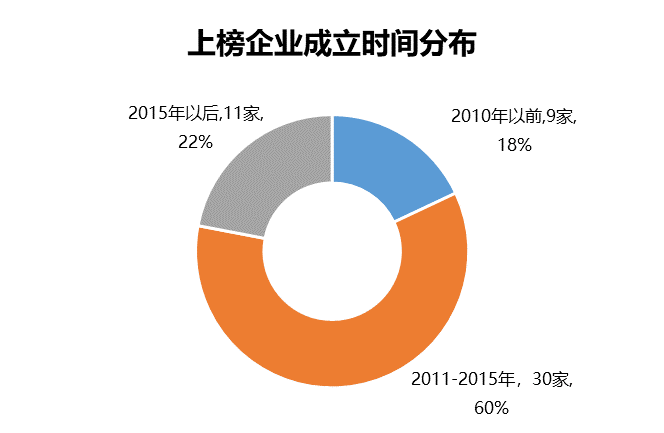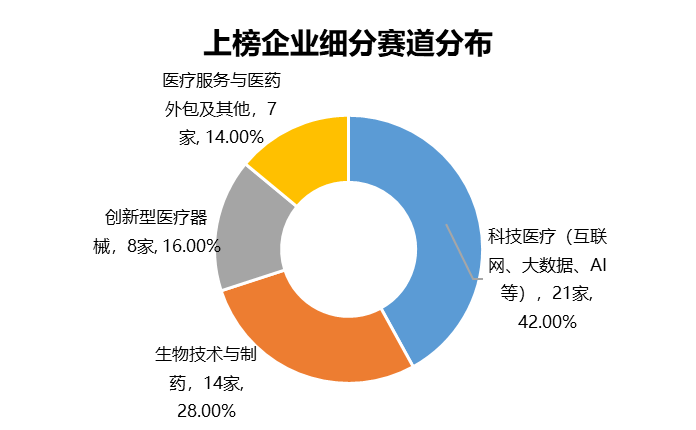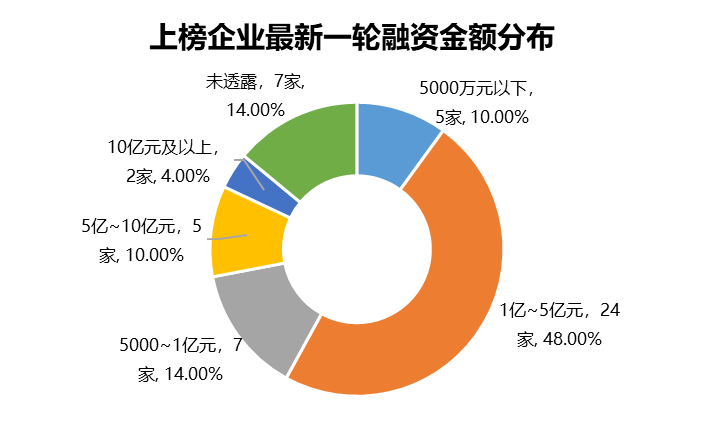[List] VentureBiz 2019 China's Top 50 Healthcare Innovation Companies Released - Growth and Innovation Against the Trend Under the Capital Winter
- Categories:Media
- Author:
- Origin:
- Time of issue:2019-09-19
- Views:0
(Summary description) "The (healthcare big health) valuation bubble is gradually being squeezed out and the market is returning to rationality."
[List] VentureBiz 2019 China's Top 50 Healthcare Innovation Companies Released - Growth and Innovation Against the Trend Under the Capital Winter
(Summary description) "The (healthcare big health) valuation bubble is gradually being squeezed out and the market is returning to rationality."
- Categories:Media
- Author:
- Origin:
- Time of issue:2019-09-19
- Views:0

"The (healthcare big health) valuation bubble is gradually being squeezed out and the market is returning to rationality."
Several investors mentioned this when asked about the biggest changes in domestic healthcare big health venture capital in recent years. They believe that after the investment and IPO boom in the healthcare industry from 2015 to 2017, the industry will usher in a major reshuffling phase, where both startups and investment institutions will face the elimination of the best and the worst, and the horse-trading effect will intensify. In the end, the top companies and institutions will survive and grow better and better.
So far this year, the financing data of the primary market can be used as evidence. Data from the Venture Capital Library shows that, as one of the key VC/PE betting tracks in the first half of 2019, there were 223 financing events in the domestic medical and health sector, with a total financing amount of RMB32.949 billion, and the financing fever in this sector has always been in the top three in China.
Although affected by the capital winter, this figure has dropped significantly compared to the 295 funding events and total funding of 38.5 billion yuan in the same period last year, the average amount of funding per project has increased and capital is converging to the head enterprises.
Yang Chao, a senior industry analyst at the Firestone Institute, has also described in an interview with Venture Capital: "After a shallow chase, capital is bound to become one of the boosters of advanced technology. At present, the industry has entered a new era of transformation and upgrading, the universal high-growth industry dynamics are gone, the exclusive market competition is about to unfold, and enterprises that truly have technological innovation and model innovation are increasingly receiving capital attention."
Therefore, even though the difficulties in VC/PE fundraising have continued to trickle down to the project side since 2018, as a typical anti-cyclical industry, medical healthcare can still buck the trend in the capital winter. With the release of the HKEx's new rules on listing and financing of biotechnology companies and the establishment of the Science and Technology Innovation Board, IPOs in the medical and health sector have performed more spectacularly this year. As of 30 August 2019, 18 medical big health companies have completed their IPOs, compared to only 16 in the whole of last year.
In recent years, new technologies such as the Internet, big data and artificial intelligence have given the healthcare industry more characteristics of the times, constantly giving rise to new models, new industries and new business models. 2019, VentureBiz has listed healthcare as one of the five most noteworthy tracks, and as a companion of innovation and entrepreneurship, we are witnessing a new stage in the development of the healthcare industry.
In April this year, VentureBang proudly launched the "Top 50 China Healthcare Innovation Companies 2019". Through nearly five months of application, research and judging, a total of 50 healthcare companies have been selected as the benchmark of this year's innovative companies in the industry. These companies cover segments such as biotechnology and pharmaceuticals, innovative medical devices, technology-based healthcare (internet, big data, AI, etc.), healthcare services and pharmaceutical outsourcing, and are the best in their respective fields.
The following is the list of VentureBiz 2019 China's Top 50 Healthcare and Healthcare Innovators

Data analysis on the 50 companies on the list.
1. Time of establishment distribution
The average establishment time of the 50 listed companies is 5.24 years, with 30 companies established between 2011 and 2015, accounting for 60%, 11 companies established after 2015, accounting for 22%, and only 9 companies established before 2010.
After the introduction of the new healthcare reform in 2009, the whole market became very active. With the growth of the immediate needs of an ageing population and the policy to encourage the development of innovative medicines in 2016, the medical and healthcare industry has received increasing attention and a large number of companies were established and grew up during this period. The current venture capital environment in China's healthcare sector is unprecedented in the past, with so much capital investment and such good policy support.

Data source: Venture Capital Research Centre
2. Regional distribution
The spatial distribution of the 50 companies on the list is relatively concentrated, with the largest number of companies headquartered in Beijing, with 18 companies, followed by Hangzhou, Shanghai and Shenzhen, with 6 companies each, and Suzhou and Guangzhou, with 5 and 2 companies respectively.
As the most developed first-tier cities in China, Beijing and Shanghai have natural advantages in terms of industrial resources, talent and access to financing. As the new first-tier cities in China, Hangzhou and Shenzhen have been gaining advantages in terms of policy, research and entrepreneurial environment in recent years, attracting many excellent medical and health care companies to grow in the region.

Data source: Venture Capital Research Centre
3. Segmented track distribution
The 50 companies on the list are mainly from the technology healthcare industry, i.e. Internet healthcare, medical big data and AI healthcare, accounting for 42%, followed by biotechnology and pharmaceutical companies with 28%, innovative medical devices and medical services and pharmaceutical outsourcing and other companies with 16% and 14% respectively.
Since April last year, while regulating technology-based healthcare, the government has also introduced a number of policies to encourage and promote the healthy development of technology-based healthcare, with "smart healthcare", "big data", "information technology Keywords such as "smart healthcare", "big data", "informatization" and "telemedicine" have also appeared several times in the "Action Plan for Further Improving Medical Services (2018-2020) Assessment Indicators" issued by the National Health Care Commission.
Founded in 2017, Digital Kun Technology reconstructs "digital heart", "digital brain" and other digital organs from medical images, which not only can fully automatically detect "lesions" and discover "It can also shorten the overall diagnosis process of a single case from over 30 minutes to 5 minutes, which greatly improves the efficiency of doctors' work and diagnostic effectiveness. In February this year, Digital Kun Technology completed a round of Series B financing of 200 million yuan.
In recent years, the biotechnology and pharmaceutical fields have also been gradually active under a series of national policies. From the first half of 2019 healthcare financing, nearly half of the financing amount was invested in biotechnology and pharmaceuticals, with innovative drugs being the top priority, with large financing events constantly occurring.
Among the companies on this list, Newflex, the first ophthalmic gene drug research and development company in China, has taken Leber's hereditary optic neuropathy (LHON) as a breakthrough, using gene therapy technology, with a view to bringing light to patients with genetic eye diseases. Newflex has now completed 159 clinical trials with an efficiency rate of 62.99% at 6 months and 63.21% at 12 months.
In the field of innovative medical devices, as the economy improves, there is a higher demand for disease risk prediction and early screening. Founded by Zou Hongzhi, an expert of the National Thousand Talents Program, Kang Liming Bio is a high-tech biological company focusing on the research and development of faecal DNA bowel cancer test kits and other early tumour diagnostic products, and its product "Changanxin" can significantly improve the detection rate of colorectal cancer and effectively reduce the incidence of colorectal cancer. Its product "Changanxin" can significantly increase the detection rate of colorectal cancer, effectively reduce the incidence of colorectal cancer, achieve early detection, early prevention and early treatment, and make a significant contribution to the health of the population.
*** Translated with www.DeepL.com/Translator (free version) ***

Data source: Venture Capital Research Centre
4. Financing rounds and financing amount distribution
The average valuation of the 50 companies on the list is RMB 1.983 billion, with the latest round of financing mainly concentrated in Series C, accounting for 36%, followed by Series A and Series B, both accounting for 28%; the latest round of financing amount in the range of RMB 100 to 500 million accounts for the highest percentage of 48%, the financing amount below RMB 100 million accounts for 24%, RMB 500 to 1 billion accounts for 10%, and over RMB 1 billion accounts for 4%.
The current Chinese population has entered an inflection point, and the medical health sector will see continued development in the next decade. Technology innovation and import substitution will drive the rapid growth of domestic medical health companies, and as the medical health industry is viewed favourably by the market and capital, there is a trend of increasing large financing for early stage projects.


Data source: Venture Capital Research Centre
5. Age of founders and overseas background
The average age of the founders of the 50 companies on the list is about 42 years old, with the youngest founder being only 30 years old. 36 founders have overseas study/working experience, accounting for 72%.
The average number of employees of the 50 companies is 365, the average number of granted invention patents of the companies is 13, and the average number of R&D staff is 95. (Statistics as at 30 June 2019)

Data source: Venture Capital Research Centre
Thanks to the huge market prospect in the domestic medical and health sector, as well as the continuous improvement of China's medical policy and the upgrading of medical consumption in the past two years, a large number of talents who have studied or worked overseas have returned to China to start their own businesses under the promotion of the national "Thousand Talents Program". However, compared with developed countries such as Europe and the United States, Chinese healthcare companies are relatively weak in independent research and development capabilities, innovation needs to be improved, and industrialisation experience needs to be accumulated, so to catch up with developed countries in Europe and the United States, more returnees and talents with international vision are needed.
Contact Us
Tel: +86-512-62956960(Recruitment)
+86-512-62956961(marketing)
E-mail:hr@cgenetech.com.cn



